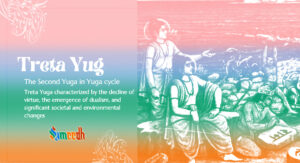Treta Yuga is the second of the four Yugs or ages in Hindu cosmology, following Satya Yug and preceding Dvapara Yug. Each Yuga is characterized by a specific set of qualities, and as the Yugas progress, there is a gradual decline in moral and spiritual values.

The duration of Treta Yuga is said to be 1.296 million years. Treta Yuga is associated with a decrease in righteousness and a greater prevalence of adharm (unrighteousness). Human life expectancy is reduced compared to Satya Yug but is still significantly longer than in the subsequent ages.
Three avatars of Lord Vishnu were said to appear during this Yug: Vaman, Parashuram and Ram as the fifth, sixth and seventh incarnations, respectively.
Popular Story: One of the most significant stories associated with Treta Yuga is the Ramayan, an epic narrative that revolves around the life and adventures of Lord Ram. The Ramayan is attributed to the sage Valmiki and provides a detailed account of the events that took place during Treta Yuga.
Key Events from the Ramayana in Treta Yuga:
- Birth of Lord Rama: Rama, the seventh avatar of Lord Vishnu, is born to King Dasharath and Queen Kaushalya in Ayodhya. His birth is celebrated as a divine event, and Ram is regarded as the epitome of virtue, dharma (righteousness), and duty.
- Exile of Lord Rama: Due to a series of events, including the manipulation of King Dasharath by his wife Kaikeyi, Ram is compelled to go into exile for 14 years. His wife Sita and loyal brother Lakshman accompany him.
- Abduction of Sita: The demon king Ravan, driven by his desire for power and Sita’s beauty, kidnaps Sita and takes her to Lanka. This sets the stage for the central conflict in the Ramayan.
- Rama’s Quest to Rescue Sita: Rama, with the help of an army of monkeys led by Hanuman, embarks on a quest to rescue Sita. The epic battle between Ram and Ravan ensues.
- Victory of Good over Evil: In a climactic battle, Rama defeats Ravan and rescues Sita. The victory of good over evil is celebrated during the festival of Diwali.
- Return to Ayodhya: After completing the exile, Rama returns to Ayodhya, where he is crowned as the king. The citizens of Ayodhya celebrate his return with great joy.
Significance of Treta Yuga:
- Dharma and Righteous Rule: Treta Yug is associated with the rule of dharma and righteousness. Lord Ram is revered as the ideal king (Maryada Purushottama) who exemplifies the qualities of a just and virtuous ruler.
- Moral and Ethical Standards: The events in Treta Yug, particularly the story of Ram, serve as a moral and ethical guide for individuals. The Ramayan provides lessons on duty, devotion, loyalty, and the consequences of adharm.
- Spiritual Aspirations: Treta Yug represents a time when people were more inclined toward spiritual practices and the pursuit of higher knowledge. The characters in the Ramayan are depicted as embodying virtues and ideals that align with spiritual aspirations.
- Transition from Satya Yuga: Treta Yug marks a subtle decline in the moral and spiritual standards from the preceding Satya Yug. While it still retains a high level of righteousness, it sets the stage for further decline in the subsequent ages.
The Yugs, including Treta Yug, are cyclical and are believed to repeat in a continuous cycle, representing the cyclical nature of time and the evolution of human consciousness in Hindu cosmology.
